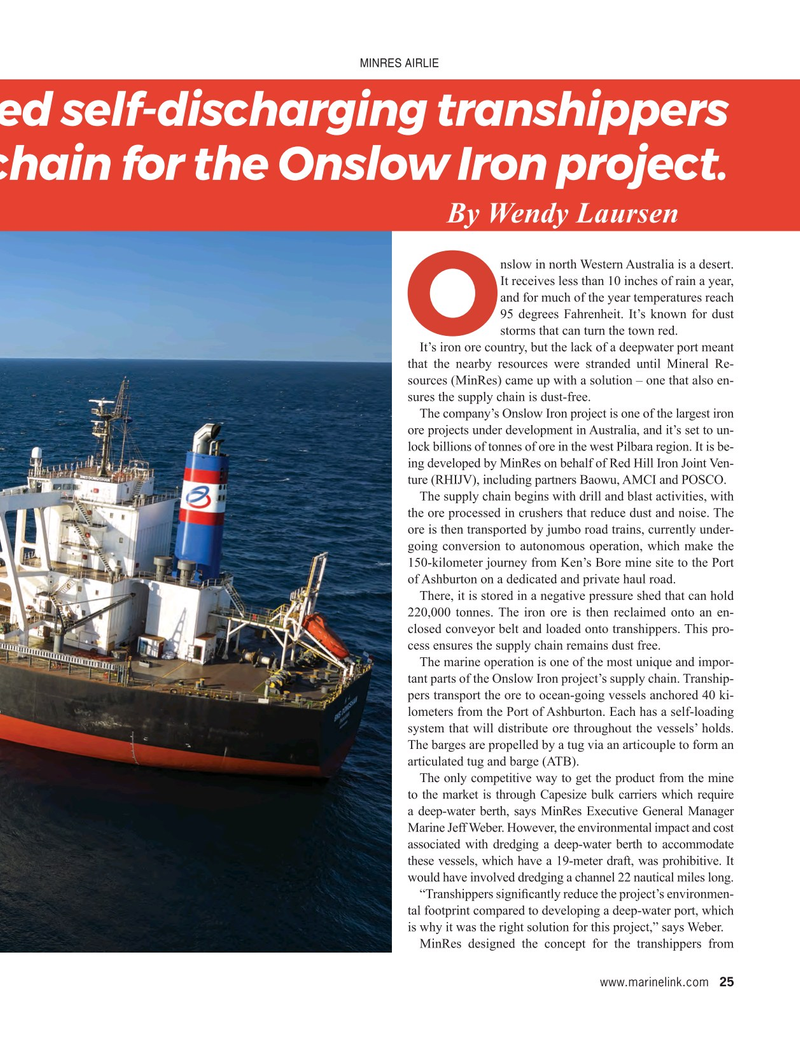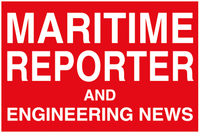
Page 25: of Maritime Reporter Magazine (June 2025)
Read this page in Pdf, Flash or Html5 edition of June 2025 Maritime Reporter Magazine
MINRES AIRLIE sed self-discharging transhippers chain for the Onslow Iron project.
By Wendy Laursen nslow in north Western Australia is a desert.
It receives less than 10 inches of rain a year, and for much of the year temperatures reach 95 degrees Fahrenheit. It’s known for dust
Ostorms that can turn the town red.
It’s iron ore country, but the lack of a deepwater port meant that the nearby resources were stranded until Mineral Re- sources (MinRes) came up with a solution – one that also en- sures the supply chain is dust-free.
The company’s Onslow Iron project is one of the largest iron ore projects under development in Australia, and it’s set to un- lock billions of tonnes of ore in the west Pilbara region. It is be- ing developed by MinRes on behalf of Red Hill Iron Joint Ven- ture (RHIJV), including partners Baowu, AMCI and POSCO.
The supply chain begins with drill and blast activities, with the ore processed in crushers that reduce dust and noise. The ore is then transported by jumbo road trains, currently under- going conversion to autonomous operation, which make the 150-kilometer journey from Ken’s Bore mine site to the Port of Ashburton on a dedicated and private haul road.
There, it is stored in a negative pressure shed that can hold 220,000 tonnes. The iron ore is then reclaimed onto an en- closed conveyor belt and loaded onto transhippers. This pro- cess ensures the supply chain remains dust free.
The marine operation is one of the most unique and impor- tant parts of the Onslow Iron project’s supply chain. Tranship- pers transport the ore to ocean-going vessels anchored 40 ki- lometers from the Port of Ashburton. Each has a self-loading system that will distribute ore throughout the vessels’ holds.
The barges are propelled by a tug via an articouple to form an articulated tug and barge (ATB).
The only competitive way to get the product from the mine to the market is through Capesize bulk carriers which require a deep-water berth, says MinRes Executive General Manager
Marine Jeff Weber. However, the environmental impact and cost associated with dredging a deep-water berth to accommodate these vessels, which have a 19-meter draft, was prohibitive. It would have involved dredging a channel 22 nautical miles long. “Transhippers signi? cantly reduce the project’s environmen- tal footprint compared to developing a deep-water port, which is why it was the right solution for this project,” says Weber.
MinRes designed the concept for the transhippers from www.marinelink.com 25
MR #6 (18-33).indd 25 MR #6 (18-33).indd 25 5/31/2025 8:10:21 PM5/31/2025 8:10:21 PM

 24
24

 26
26
